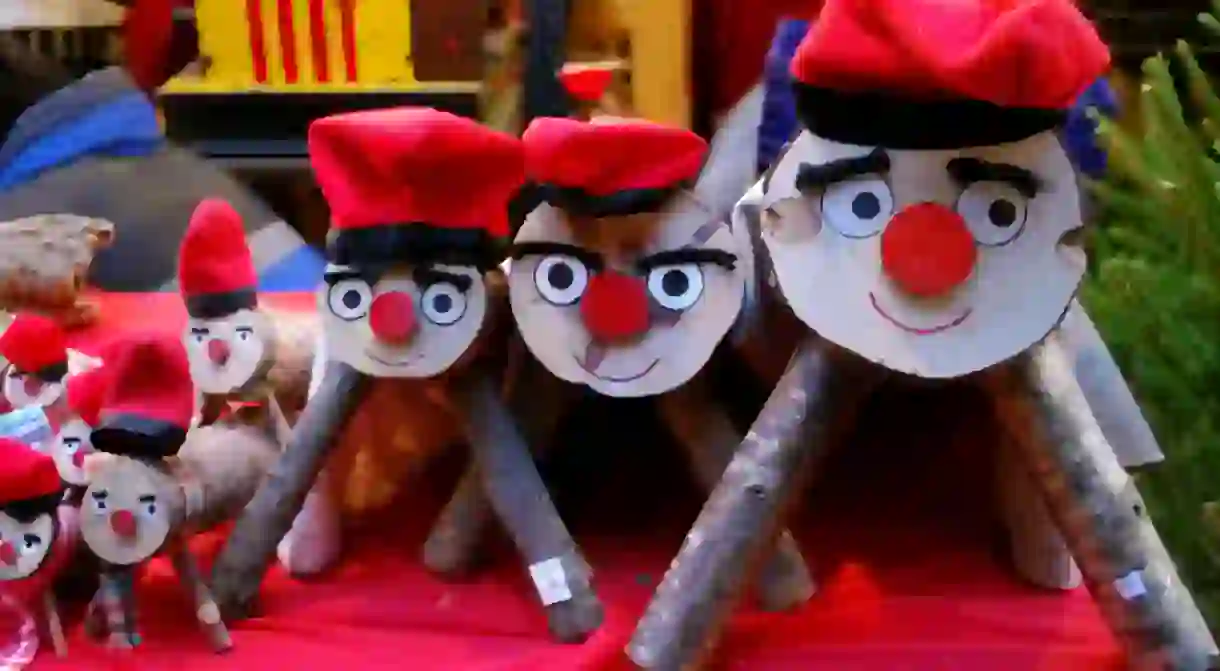Who Is Caga Tió, and Why Do Kids Beat Him Up?

Old Caga Tió is one of the most highly anticipated holiday guests in homes across Catalonia and Aragon around Christmastime. This cheerful character is renowned for his generosity towards small children, offering them gifts and treats – despite their poor treatment of him. It just so happens that the best way to get Caga Tió to bear his rewards is by beating him with a stick. Find out who this unfortunate character is and how he invited himself into Catalan households.
Who is Caga Tió?
As anyone who knows a bit of Catalan might have guessed by now, Caga Tió literally means the ‘Pooping Log’, and this gives a lot away in terms of understanding what this curious guest gets up to. Practically speaking, the Caga Tió – or Tió de Nadal (Christmas Log) as he is sometimes called – is a smallish wooden log, covered in a blanket and usually given a warm, smiley face. You’ll find Caga Tió for sale in Christmas markets across the two main provinces from which he originates, Catalonia and Aragon. Come Christmas time, the log is expected to ‘poop’ presents for children and their parents, much to the amusement and amazement of younger spectators.
What does Caga Tió do?
The story has it that Caga Tió arrives at the doorstep in early December, usually around the time of the Feast of the Immaculate Conception on 8 December. Those he visits are expected to take him in and take care of him in the run-up to Christmas Day. Children are told to ‘feed’ Caga Tió dry bread, orange peel or dried beans, and in the days just before Christmas, children are told to take extra care of Caga Tió if they want him to bear gifts on Christmas Eve.
This is where it becomes fascinating. In order for the Caga Tió to produce his gifts, children are instructed to beat him with a wooden stick and sing to him, ordering him to poop presents. A common Catalan version of the song goes along the lines of:
Poop, log,
poop nougats (turrón),
hazelnuts and mató cheese,
if you don’t poop well,
I’ll hit you with a stick,
poop, log!
Another common version is:
Log of Christmas,
poop nougats,
pee white wine,
don’t poop herrings,
they are too salty,
poop nougats (turrón)
they are much better!
Just before hitting the Caga Tió, children are instructed to go out of the room and pray that the Uncle will provide them with lots of gifts. This is when parents usually seize the opportunity to hide the gifts beneath the Caga Tió’s cloak, while the kids are not looking. When the kids return, the gifts are unveiled one by one until there are no more, at which point it’s not uncommon for the Caga Tió to produce an onion or cured herring.
How did the Caga Tió come about?
The history of the Caga Tió shows that originally he was simply a large log cut by adults and brought into the house before Christmas. The log symbolised the gifts of warmth and light that were given by the earth in the form of wood. As the practice became more widespread, commercial versions of the log appeared, with a painted face and red blanket.
Traditionally, the Caga Tió always produced relatively small gifts that were destined for all to enjoy communally, not individual gifts. The most common presents offered by the log include turrón (a Catalan nougat), small sweets and biscuits, as well as dried fruits such as candied orange peel or figs.
In recent years, the Caga Tió has grown in popularity in the regions of Catalonia and Aragon, where it is seen as an important part of the unique cultural heritage of each region. As a result, the gifts have tended to become more important, and the Caga Tió plays a similar role to that of Santa Claus in the USA.













